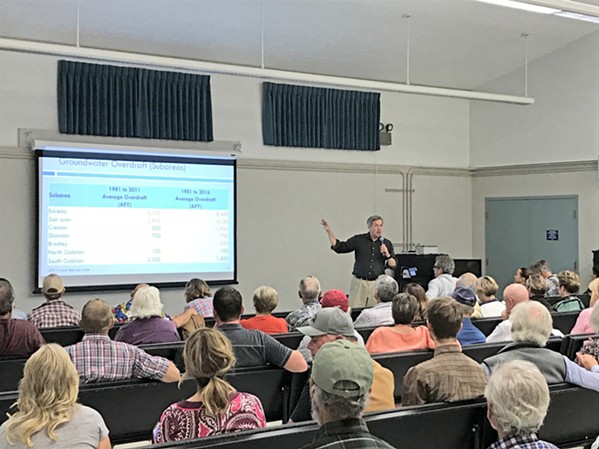[{
"name": "Ad - Medium Rectangle CC01 - 300x250",
"id": "AdMediumRectangleCC01300x250",
"class": "inlineCenter",
"insertPoint": "8",
"component": "2963441",
"requiredCountToDisplay": "12"
},{
"name": "Ad - Medium Rectangle LC01 - 300x250",
"id": "AdMediumRectangleCC01300x250",
"class": "inlineCenter",
"insertPoint": "18",
"component": "2963441",
"requiredCountToDisplay": "22"
},{
"name": "Ad - Medium Rectangle LC09 - 300x250",
"id": "AdMediumRectangleLC09300x250",
"class": "inlineCenter",
"insertPoint": "28",
"component": "3252660",
"requiredCountToDisplay": "32"
}]
Voices took to the streets, city halls, county chambers, and the internet (but we aren't going to go there!) this year as the election took off and national politics hit home. It wasn't a quiet year—and maybe that's a good thing. The more voices the merrier, right? Residents and candidates debated local issues such as housing, water, cannabis, public safety services, oil, and wastewater. Activists took to the streets to protest racism on Cal Poly's campus, deaths in the county jail, and sexual assaults. Yes, it is the end of the year already, and it did go by so fast. But now's your chance to put up your feet and take a look back at all we went through together before 2018 turns into a pumpkin.
—Camillia Lanham
ELECTION 2018: Harmon trumps Gurnee for SLO mayor
"I am done pretending that this is a real discussion about which progressive is the real progressive," Heidi Harmon told SLO Progressive Club members as her election opponent, T. Keith Gurnee, stood next to her. "Because there is only one progressive up here tonight, and I think you all know who that is."
Harmon's admonishment of Gurnee at a July 26 progressives' forum, followed by the "mic drop heard 'round SLO," kicked off a tense, bitter fight for SLO's mayorship that wouldn't stop until election night.
Gurnee, a City Council member in the '70s, promised to save the city from overdevelopment, intrusive bike paths, and liberal policies. Incumbent Harmon doubled down on her environmentally ambitious net-zero
platform and emphasis on social and economic inclusivity. With Harmon's more than 30-percentage-point victory, voters made their choice of visions clear.
—Peter Johnson
Arroyo Grande gets a new council
Arroyo Grande saw a major shift in the make up of its City Council as a result of the November elections. Sitting Councilmember Caren Ray ousted embattled two-term Mayor Jim Hill. In addition, councilmembers Tim Brown and Barbara Harmon declined to run for re-election. Newcomers Jimmy Paulding, who ran and lost a race for 4th District Supervisor in June, and Keith Storton, a retired SLO Police Department captain, beat out a crowded field of candidates to win spots on the council. As their first order of business, the council plans to fill the vacant seat left by Ray's election to mayor by appointment in early January.
—Chris McGuinness
Paulding falls short against Supervisor Compton
Fresh-faced Arroyo Grande native Jimmy Paulding gave incumbent Supervisor Lynn Compton a run for her money in the race for SLO County's 4th District Board of Supervisors seat, but the 32-year-old ultimately fell short by a mere 60 votes. The campaign was intense, with Paulding criticizing Compton's votes, temperament, motives, and campaign donors, and Compton characterizing Paulding as privileged and a "kid."
A critical swing vote on the politically split Board of Supervisors was at stake. Compton sought to maintain the three-member conservative majority; Paulding aimed to tip the board in a progressive direction. As a result, big money flowed into the race and the candidates collectively raised nearly $1 million for their campaigns.
—Peter
Cash rolls in for Measure G fight
Oil companies spent more than $8 million to fight a ballot measure that would have banned fracking and new oil and gas wells in the unincorporated areas of San Luis Obispo County. Measure G qualified for the November ballot after receiving more than 20,000 signatures earlier this year.
The No on Measure G campaign said that should the measure pass, it would shut down all current and future oil production in the county, a claim that the Yes on Measure G campaign denied. Yes on G raised $242,000 in cash and in-kind donations, but campaign co-chair Charles Varni told New Times that the campaign didn't have enough resources to adequately battle the unprecedented amount of money raised by the opposition. Measure G lost by 7 percent of the vote or almost 9,000 votes.
"This really wasn't an exercise in democracy. This was never a level playing field," Varni said.
—Camillia
CANNABIS ROLL OUT: SLO city readies for business
The central hub of the county took its sweet time enacting regulations to introduce a legal cannabis market in the community, retaining its blanket ban on pot for much of 2018 as officials also slogged through an overhaul of citywide zoning.
But by year's end, the City Council passed a freshly minted ordinance that positions SLO as one of the more canna-liberal municipalities on the Central Coast—in spite of annual fees that will run up to $95,000 per business. Stay tuned in 2019 for three brick-and-mortar stores opening, as well as new delivery, manufacturing, testing, and indoor cultivation operations.
—Peter
Grover Beach dispensaries open
In 2018, Grover Beach took a major step toward becoming one of most cannabis-friendly cities in SLO County.
In the lead up to 2018, the city approved allowing commercial cannabis businesses in the city, including growing, manufacturing, distribution, mobile delivery, and brick-and-mortar retail operations. In total, the city permitted four medical and recreational dispensaries to operate within the city limits. The first of those, 805 Beach Breaks, opened in May, quickly followed by a second shop, Natural Healing Center. The city welcomed both businesses with open arms, even sending officials to participate in ribbon-cutting ceremonies to mark the occasion.
With more commercial cannabis businesses set to come online in 2019, the city has already gotten a glimpse of the potential economic impact of the new industry. In the first quarter of 2018, the city raked in $120,000 from its commercial cannabis tax.
—Chris
County struggles with permits and enforcement
SLO County wrestled with implementing its own cannabis regulations this year—which many called tediously convoluted and overly restrictive. Permit applications piled up at understaffed county offices while enforcement officials chased down hundreds of illegal grows in the California Valley.
By year's end, the county had issued just a handful of cannabis permits, but levied close to $1 million in fines to illegal operations. Dozens of applicants are still awaiting hearings, while fewer than half of the county's roughly 160 eligible cultivators have submitted applications—spurring multiple deadline extensions. County leaders are more optimistic about 2019, though, with their much-needed hiring of a full-time director of the Planning and Building Department—Trevor Keith.
—Peter
RACIAL TENSION AT CAL POLY: Upheaval on campus
On April 7, a photo of a Cal Poly Lamdba Chi Alpha fraternity member in blackface circulated on social media, sparking local and national media coverage. The incident reignited long-standing concerns over incidents of racial insensitivity and a lack of diversity on campus.
In the weeks that followed, the university placed all of Greek Life on interim suspension. Along with the blackface controversy, other incidents involving fraternities—including racially charged and insensitive events, sexual assaults, hazings, an alcohol-related death, and violations of the university's code of conduct regarding hosting social events—led to the university's decision.
On May 4, Cal Poly President Jeffrey Armstrong announced another blackface photo that was shared with a private group of fraternity members on Snapchat. Both blackface incidents as well as reports from other fraternities and sororities were turned over to the California Attorney General's Office for investigation. On Oct. 2 Armstrong released a campus-wide email stating that the First Amendment protected the students who were involved in the racially charged incidents.
—Karen Garcia
ANDREW HOLLAND: Calling for change
The death of SLO County Jail inmate Andrew Holland may have occurred in 2017, but the controversy and outrage surrounding his death continued to have an impact on policy and politics in SLO County well into 2018.
In March, the SLO Tribune released portions of video surveillance footage of Holland's death, which occurred after the schizophrenic was strapped into a restraint chair for nearly two days, sparking public outcry and protest against SLO County Sheriff Ian Parkinson. Holland's death became a major issue in the race between Parkinson and his challenger, former SLO police officer and local private investigator Greg Clayton, in the June primary elections. Clayton had the support of the Holland family, which donated thousands of dollars into his campaign. Parkinson's supporters responded by flooding his campaign coffers as well.
Parkinson got re-elected and pledged to continue working with the county to implement reforms at the jail. Those included building a new medical clinic, hiring a jail chief medical officer, and more recently, outsourcing medical, dental, and mental health services at the jail to private correctional health contractor Wellpath. The jail remains under investigation by the FBI and the U.S. Department of Justice.
—Chris
DEVELOPMENT AND HOUSING: A debate over affordability
The San Luis Obispo County Board of Supervisors closed out the year by passing a new way to fund affordable housing in the county. A coalition of affordable housing advocates, developers, and the business community helped bridge the divide between the conservative and liberal sides of the board—a divide that led to years of decision-making stagnation about the county's affordable housing program. A three-year pilot program is expected to raise between $2 million and $4 million each year for the county's affordable housing fund.
In the city of San Luis Obispo, the debate over what kind of development should be allowed in the city rages on. With at least 68 commercial projects larger than 5,000 square feet in the city's planning pipeline this year, the conversation over building was a large part of 2018's City Council and mayoral election campaigns. City character sparred off with a need for housing in the wake of new housing laws passed by the state Legislature in 2017 aimed at building more housing units that will help alleviate the state's housing and homeless crises—both of which are affecting the city and county. Residents argued over building heights, subdivisions, what constitutes affordable housing, and how building affordable units into projects should affect developers.
As the argument over housing and commercial development continued, cities across the county declared homeless shelter crises in preparation for the incoming inclement winter weather and the long-anticipated $5.2-million homeless services center opened on Prado Road in SLO. The 20,000 square foot building known as 40 Prado is meant to combine the services offered at the Prado Day Center and Maxine Lewis Shelter, as well as provide other services such as medicine, counseling, childcare, and career resources.
—Camillia
SEXUAL ASSAULT REMAINS A CONCERN: #MeToo hits home
Tackling the issue of sexual assault and rape remained a challenge in SLO County in 2018.
In March, a New Times investigation found that despite recording more reported rapes than any other law enforcement agency in the county, only a handful of the SLO Police Department's investigations resulted in felony criminal charges being filed in SLO County Superior Court. The story raised questions about whether local law enforcement was doing enough to address such crimes.
The county also experienced a high-profile sexual assault and rape case. The criminal case against Alfonso Alarcon-Nunez, an Uber driver accused of raping young female passengers, remains ongoing. It prompted 35th District Assemblymember Jordan Cunningham (R-SLO) to introduce a bill that strengthened background checks for rideshare drivers. The bill was signed into law in September.
Controversy surrounding the confirmation of U.S. Supreme Court Justice Brett Kavanaugh in late September once again brought the issue to the forefront in SLO County. Women's March SLO organized a rally during the confirmation hearings and collected stories of sexual assault and harassment from local women. RISE, a local nonprofit organization that provides services and support for victims of sexual assault and domestic violence, reported that calls to its sexual assault hotline increased by 322 percent from the previous year.
There is little chance that issue will disappear in 2019. RISE announced that it plans to roll out a new sexual violence prevention program called "Close to Homes" in the city of SLO beginning in February.
—Chris
WASHINGTON POLITICS AT HOME: Immigration and school shootings spark local protests
SLO County residents young and old gathered in 2018 to organize and participate in protests over hotly debated national issues.
In March, hundreds of high school students in SLO County participated in a national walkout to protest gun violence. The walkout was organized in the wake of a mass shooting at Marjory Stoneman Douglas High School in Parkland, Florida. The walkouts occurred at high school campuses in SLO, Arroyo Grande, Morro Bay, Nipomo, and others.
In June, a crowd of about 1,500 people gathered in front of the SLO County Courthouse before marching through downtown SLO to protest the separation of undocumented immigrant children from their parents at the U.S.'s southern border by U.S. Immigration and Customs Enforcing (ICE). At the rally, speakers called on ICE and the administration of President Donald Trump to end the policy and reunite the more than 2,000 children taken from their parents. The rally was part of a nation-wide protest against the policy, which the administration later rescinded.
—Chris
Feds eye oil and gas development on the Central Coast
In August, New Times reported how the U.S. Department of Interior was examining expansive swaths of public lands in SLO County, including landmarks like Morro Rock, as potential fracking sites in an environmental study. The news kicked off a frenzy on the Central Coast (Santa Barbara and Ventura counties were also included), and members of the public wound up submitting more than 8,000 individual comments to the Bureau of Land Management (BLM) about the study. The BLM has not issued a new oil or gas lease on California public lands in more than five years, but community members are concerned about a pivot under the Trump administration. In March, the BLM ok'd jumpstarting an oil well on the Carrizo Plain that was previously set for restoration.
—Peter
FIRE SERVICES: Not enough money
Fire departments throughout San Luis Obispo County faced two big issues this year: retaining reserve firefighters and having enough funding to provide services to their community.
The Cayucos Fire Department had been dealing with these issues for four years, but against the community's wishes, it ultimately had to dissolve and hand its keys over to San Luis Obispo County in December. The department was paid for through a special fire tax of $100 per household on top of property taxes, but it wasn't enough. The community had an opportunity to raise the tax to $125 in 2016, but voted against it.
In the June 5 primary election, the Cambria community rejected Measure A-18, a tax of $62.15 per parcel owner, which would have paid for three full-time firefighters and maintained staffing levels.
The Five Cities Fire Authority, which serves Oceano, Arroyo Grande, and Grover Beach, amended its joint powers agreement for fire coverage due to increasing expenses. According to the agreement for the 2018-19 fiscal year, Arroyo Grande will contribute $2.5 million, Grover Beach will pay nearly $1.8 million, and Oceano will put forth $987,362 to fund fire services.
In North County, Templeton Fire and Emergency Services provides service between 8 a.m. and 5 p.m. and only has one fire captain. Its operations are funded by an antiquated property tax that was established when the district formed in 1976. In 2009, Templeton voters rejected a proposed special tax assessment that would have aided in the department's funding gap. In December of this year, the district directed staff to start the research process for a future special election for a special parcel tax to funds its fire department.
—Karen
MORRO BAY: Wastewater project finalized
After years of proposed sites, project cost changes, a new city manager and constant communication with the community, the city of Morro Bay finally took a leap forward on its new wastewater reclamation facility on Oct. 23. The council voted to award $67.2 million in a design and construction contract to Filanc/Black & Veatch, a San Diego firm.
The city's next hurdle was funding the project, which it successfully locked in after a controversial Proposition 218 vote to hike water and sewer rates. Utility bills for ratepayers could be as low as $168 or as high as $233, with the average customer paying $191. In order to potentially reduce the project's overall budget, the city is going to apply for loans.
But before the city could really rejoice in its accomplishments, the community vocally opposed the results of the Proposition 218 vote. Residents who opposed the city's water reclamation facility project challenged the city's refusal to count approximately 1,000 votes in protest of the water and sewer rate hike. The threat of litigation was enough for then City Councilmember, now mayor, John Headding to move to agendize acknowledging the votes without having them count toward the water and sewer rate hike protest. It was what Headding called a first step in the process of trying to re-establish a solid foundation of communication between the city and its residents.
—Karen
WATER: (Ground)water remains front of mind
Drought conditions may have improved in 2018, but water (and the lack of it) remained a high priority for residents and local governments throughout the year.
Farmers and communities over the Paso Robles Groundwater Basin came together (and at times clashed) over the writing of a basin sustainability plan, a document that must be submitted to the state by 2020, according to the Sustainable Groundwater Management Act (SGMA). In March, SLO County supervisors denied the Estrella-El Pomar-Creston Water District a chance to participate in the plan. Meanwhile, stakeholders over the SLO and Cuyama Valley basins also formed groundwater agencies and boards to tackle SGMA's requirements.
In October, a five-year-old North County water rights court case wrapped up: a Bay Area jury issued a mixed-bag ruling that acknowledged the right of the city of Paso Robles, the county, and the San Miguel and Templeton community services districts to purvey groundwater during a drought—but potentially curtailed that right. A coalition of private landowners and farmers sued the public agencies in 2013, bemoaning overpumping and overregulating.
In the communities of Adelaida and west Templeton, landowners also sounded the groundwater alarms. With water use regulated over the Paso basin, Adelaida residents decried an influx of vineyard development and deep well drilling. County supervisors promised to look at policy solutions in 2019.
Residents and vacationers at Lake Nacimiento feuded with Monterey County this year over its rapid water release schedule, out of the reservoir and into the Salinas River. Stay tuned in the New Year for a lawsuit that the lake community promises to file in response. Δ
—Peter
New Times editorial staffers are excited for 2019, but we're not sure what it will bring. Send us an email and tell us what you think!
Latest in News
Comments
Showing 1-1 of 1
Readers also liked…
-

Coast Unified teachers upset over new position's salary and qualifications
Oct 20, 2022 -

SLO police identify alleged driver who hit and killed couple
Dec 22, 2022 -

When the levee breaks: Oceano residents, county officials walk a tightrope of regulations to manage Arroyo Grande Creek, which some say led to the levee's failure in January
May 18, 2023


















